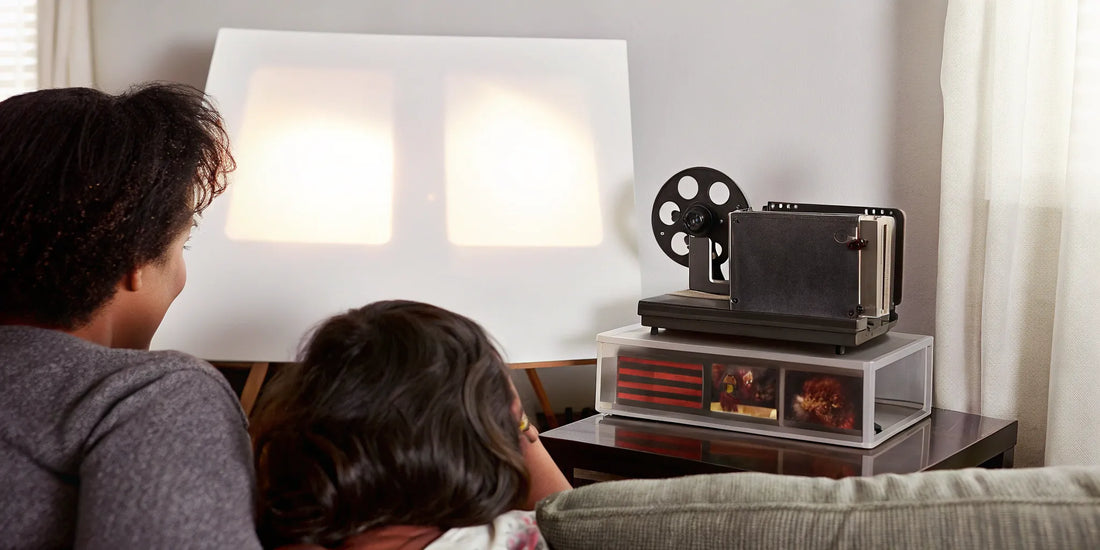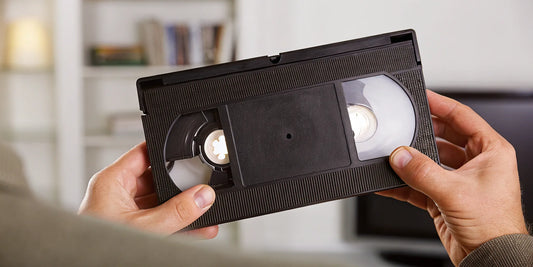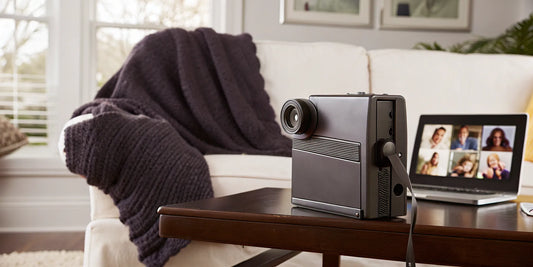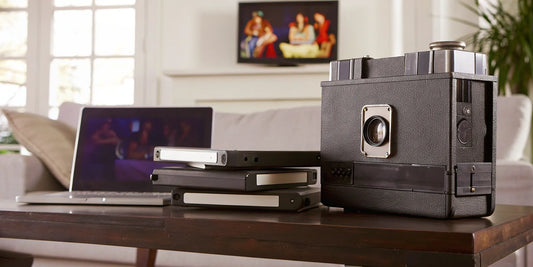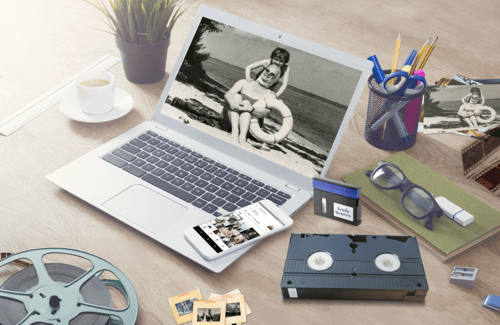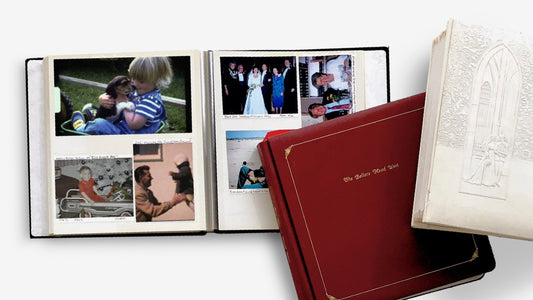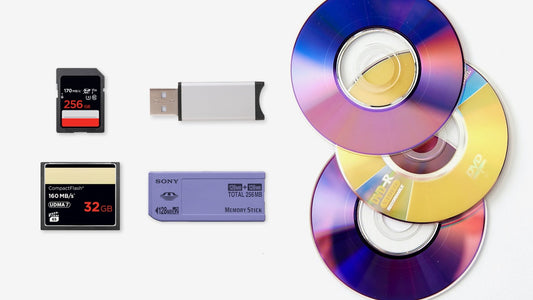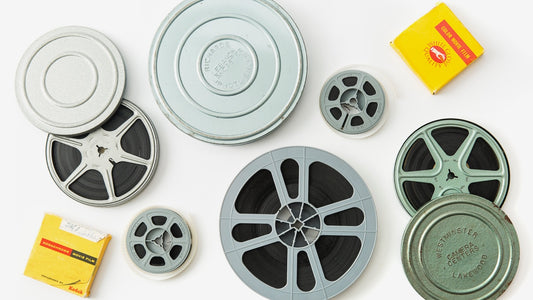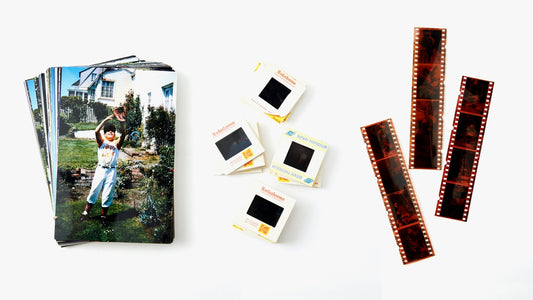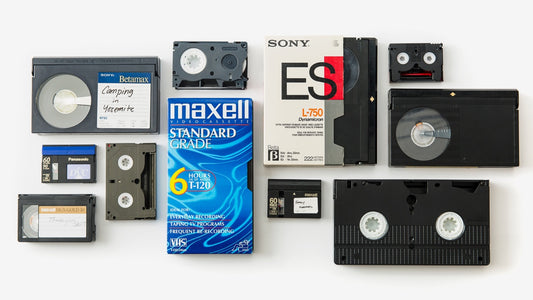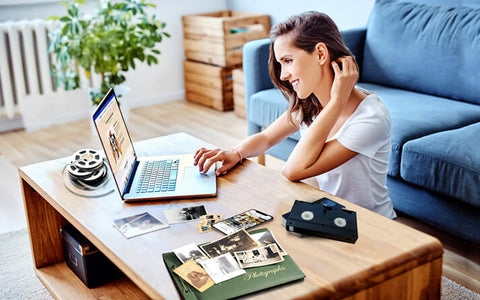Slides capture moments in time like no other format. That click of the projector, the soft glow of the image on the screen—it's pure nostalgia. But those physical slides are vulnerable. They can fade, deteriorate, or get lost or damaged. Slide digitization is the best way to safeguard these irreplaceable memories. This guide will walk you through everything you need to know, from choosing the right service to understanding the costs. We'll also explore the benefits of professional digitization versus doing it yourself and offer tips on preparing your slides, ensuring those precious memories are preserved for generations.
Key Takeaways
- Protect your visual legacy: Digitizing slides preserves fragile memories, safeguarding them from damage and deterioration while ensuring easy access for future generations.
- Professional services simplify digitization: Entrusting your slides to professionals offers high-quality scans, convenient handling, and often includes valuable extras like color correction and image enhancement.
- Share your memories effortlessly: Digital slides are easily shared with loved ones near and far through email, social media, online albums, and personalized slideshows.
Why It's Time to Digitize Your Slides
Remember those carousel slide projectors and the click-click-click sound they made? Those slides hold a treasure trove of memories, capturing moments you likely haven't seen in years. But slides are fragile. They can fade, deteriorate, or get damaged by humidity, heat, and time. Digitizing your slides gives those precious memories a new lease on life. It's the best way to preserve those special moments and share them with future generations. Plus, once they're digital, sharing with family and friends near and far is easy.
Those slides are a unique piece of your family history, representing a specific era of visual storytelling. Digitizing them, whether you do it yourself or use a professional slide transfer service, protects these irreplaceable memories. Imagine losing those images to a flood, fire, or simply the slow fade of time. Digitizing creates a backup, ensuring those captured moments are safe.
Once your slides are digital, sharing is incredibly easy. No more lugging out the projector and screen! You can instantly share memories with family and friends through email or social media, reconnecting over shared experiences. You can also create digital albums, slideshows, and even incorporate images into other projects.
Converting slides to digital might seem daunting. You might be worried about the technical aspects, finding the time, or the cost. The long-term benefits of preserving your memories far outweigh any initial hurdles. Digitizing your slides ensures that the vibrant colors, the tiny details, and the stories they tell remain vivid for years to come. It's about safeguarding your legacy and making sure those special moments are never truly lost.
The Best Slide Digitization Services Reviewed
Digitizing your slides protects your memories and makes sharing them with family and friends easy. Choosing the right service can feel overwhelming, so I've broken down some of the top options available.
A Look at YesVideo
YesVideo makes sharing memories simple with direct integration with Google Photos. This means your digitized photos are readily available online and easy to organize. The service includes a digital copy and access to their MemoryCloud platform, where you can view, download, and order prints. Find out more about their photo transfer options.
Our Process and Promise
Handing over a box of irreplaceable memories can feel like a huge leap of faith. We get it. That's why we've spent over 20 years building a process centered on trust and quality. When you send your slides to YesVideo, you're not just sending them to a company; you're entrusting them to a team of trained technicians who handle every single order by hand, right here in the USA. We promise to treat your memories with the same care we would our own, ensuring a safe journey through our digitization process and delivering high-quality digital images that you and your family will be proud to share.
What Slide Formats We Digitize
You might be wondering if we can handle the specific type of slides you have stored away. The answer is almost certainly yes. Our technicians are equipped to digitize a wide variety of formats, ensuring your visual history is preserved no matter how it was captured. We can process 35mm, Super 35mm, 110, 126, 127, and 127 Superslide formats. Each slide is individually and carefully scanned by hand to capture the best possible image. If you have a collection ready to go, you can learn more about our slide transfer service and get started on protecting those memories today.
A Look at Legacybox
If you want to ensure your slides are handled with care, Legacybox might be a good choice. They specialize in enhancing image quality with color correction. They send you a kit with pre-paid shipping, and they return your originals after digitization. Plus, they'll keep you updated throughout the process. Learn more on their slide to digital conversion page.
Key Stats and Policies
As you compare services, a few key details can help you make a confident choice. Pay attention to scanning quality—you want your images to look their best. Some services, like Nostalgic Media, offer high-resolution 3,000 DPI scans to capture every detail. Cost is another important piece of the puzzle. You’ll find a range of prices, with options like ScanMyPhotos starting at just 65 cents per slide. If you need your memories back quickly, look for services that promise a fast turnaround, often within 7 business days. Don't forget to check for extras, too. Legacybox includes color correction and sends a handy shipping kit, and their track record with over 1 million customers speaks for itself. Keeping these points in mind will help you find the perfect home for your slides.
A Look at Nostalgic Media
Nostalgic Media focuses on high-resolution scanning at 3,000 DPI. This ensures your images look great on screen and are suitable for printing. With a typical turnaround time of 7–10 business days, you'll receive your digital images quickly. See their slide scanning service page for details.
Key Stats and Policies
As you compare services, a few key details can help you make a confident choice. Pay attention to scanning quality—you want your images to look their best. Some services, like Nostalgic Media, offer high-resolution 3,000 DPI scans to capture every detail. Cost is another important piece of the puzzle. You’ll find a range of prices, with options like ScanMyPhotos starting at just 65 cents per slide. If you need your memories back quickly, look for services that promise a fast turnaround, often within 7 business days. Don't forget to check for extras, too. Legacybox includes color correction and sends a handy shipping kit, and their track record with over 1 million customers speaks for itself. Keeping these points in mind will help you find the perfect home for your slides.
A Look at ScanMyPhotos
ScanMyPhotos handles a variety of media, including slides. They offer different scanning formats and a simple ordering process, making digitizing your collection convenient. Visit their website to explore their services.
Key Stats and Service Tiers
Choosing a service comes down to what matters most to you. Are you looking for the highest possible image quality, the fastest turnaround, or the most budget-friendly option? To help you decide, here’s a quick comparison of the key features and stats for each service we’ve discussed.
- YesVideo: We make it easy to digitize your photos with direct Google Photos integration for simple sharing and organizing. Every order is processed by hand in the USA, and you receive a digital copy plus access to your memories on our secure MemoryCloud.
- Legacybox: They focus on a guided experience, sending you an all-in-one mailing kit to convert slides. Their process includes color correction and regular updates, so you always know where your memories are.
- Nostalgic Media: If you’re looking for high-resolution images and a quick turnaround, their slide scanning service offers 3,000 DPI scans and aims to have them back to you in 7–10 business days.
- ScanMyPhotos: This service provides flexible options with Standard (2,000 DPI) and Premium (4,000 DPI) scanning tiers. With prices starting at 65 cents per slide, it’s a cost-effective choice for larger collections. You can learn more about their offerings on their website.
As you can see, each service offers something a little different. Whether you value the convenience of an all-in-one kit or the flexibility of various scanning resolutions, there’s a great option for you. The most important step is choosing one, so you can stop worrying about your slides and start enjoying the memories locked inside them.
A Look at DigMyPics
DigMyPics prioritizes high-quality scanning for slides, negatives, and photos. They offer various services, including color correction and multiple digital delivery formats, so your images retain their original quality. Visit their site for details on their slide scanning services.
Breaking Down the Cost of Slide Digitization
Digitizing slides is an investment in preserving your memories. Understanding pricing structures and factors that influence cost will help you find a service that fits your budget and needs.
Understanding Common Pricing Models
Most slide digitization services use tiered pricing based on volume. Some companies, like Costco, offer a simple per-slide rate, currently $0.32 per slide with a $19.99 minimum. This structure is great for smaller collections. Other services, such as Nostalgic Media, offer per-slide pricing that decreases with larger orders, ranging from $0.46 to $0.42 per slide with a $30 minimum. This incentivizes digitizing a large collection at once. You'll also find services like Legacybox that offer “kits” designed for different quantities, with prices varying based on the kit size. For example, their starter kit handles up to two items for $69.98. YesVideo offers a variety of digitization services, including options for video transfer, film transfer, and photo transfer, allowing you to preserve all your precious memories.
Alternative Pricing: Prepaid Boxes and Payment Plans
Beyond standard per-slide rates, many services offer alternative pricing to make digitizing more manageable. Prepaid boxes, like those from Legacybox, are a popular option. You purchase a kit designed for a specific number of "items"—where one item might be a tape, a film reel, or a bundle of 25 slides. This all-in-one approach simplifies the process by including shipping and a set price, so you know the total cost upfront. For larger collections, the total cost can add up. That's where payment plans come in. Services like ScanMyPhotos partner with financing companies, allowing you to spread the cost over several months. These flexible options help make preserving your entire family history more accessible, removing a financial hurdle so you can focus on protecting your memories.
What Influences the Final Price?
Beyond the base digitization fee, several factors can influence the final cost. The most significant factor is the number of slides you have. As mentioned, many services offer volume discounts, so the more slides you convert, the lower your per-slide cost may be. Additional services also impact the total price. These can include extra DVDs or USB drives, custom folders or cases, and special handling for delicate slides. If your slides require extra care, be sure to ask about potential surcharges. Finally, turnaround time can affect pricing. While standard processing times typically fall within a few weeks, some services offer rush orders for an additional fee. YesVideo also provides services for album scanning and digital media transfer, ensuring a comprehensive solution for all your media preservation needs.
Minimum Order Charges and Extra Fees
Most digitization services have a minimum order charge to cover the basic costs of handling and setting up your project. This fee ensures that even small orders are feasible for the company to process. For example, a service might have a $30 minimum for any slide scanning order. Beyond the minimum, extra fees can apply depending on your specific needs. If your slides are in special formats, like metal holders or plastic binder sleeves, you might see a small surcharge per slide because they require more careful, manual handling. Additionally, if you want your digital files organized into custom-named folders, there's often a nominal fee for that service, usually around $5 per folder.
Shipping Costs and Available Discounts
Shipping is a crucial part of the process, covering the journey of your slides to the lab and back to you. Many companies structure their shipping costs to reward larger orders. It's common to see offers like free return shipping for orders that meet a certain threshold, such as $200, while smaller orders might have a flat-rate return shipping fee of around $14. Before placing your order, it’s always worth checking for available discounts. Some companies provide a standing discount on their services, which can significantly reduce the total cost, especially if you have a large collection of slides to digitize. A quick look at a company’s website for promotions can lead to some welcome savings.
What's the Turnaround Time for Slide Digitization?
Digitizing slides takes time, and how much depends on a few factors, including the service you choose, the number of slides you have, and whether you opt for standard or rush processing. Let's break down the typical timelines so you can plan accordingly.
What to Expect for Standard Turnaround
Most slide digitization services estimate standard turnaround times in weeks, not days. For example, YesVideo generally quotes 2–3 weeks for standard orders. Similarly, Legacybox also estimates 2–3 weeks for standard processing. If you're not in a hurry, these services offer a good balance of careful handling and reasonable turnaround. Nostalgic Media offers a potentially faster option, typically completing slide scanning in 7–10 business days.
Comparing Timelines: From Days to Weeks
When you're ready to digitize, you'll find that turnaround times can range from about ten business days to several weeks. The right choice often comes down to balancing speed with peace of mind. Services like YesVideo offer a standard 2–3 week timeline, which is a great benchmark for careful, hand-processed digitization that ensures your memories are treated with respect. If you have a specific deadline, like an anniversary or a family reunion, a faster service might be appealing. However, for most people, a few weeks is a reasonable wait to ensure decades-old slides are preserved properly for the future. This timeframe allows you to select a trusted service without rushing the process.
Need Your Slides Back Sooner? Rush Options Explained
Need your slides digitized quickly? Many services offer rush options, although this usually comes at a premium price. Legacybox can expedite orders, completing them in as little as 10 days. Nostalgic Media also offers rush services—contact them directly to discuss your specific needs and timeline. YesVideo has a premium service with expedited processing, usually completing orders within 30 days. While not as fast as some other rush options, it's still faster than their standard service. When considering a rush order, always confirm pricing and the guaranteed turnaround time with the provider.
What Image Quality Can You Expect?
Digitizing slides isn't just about preserving them; it's about giving them a new life. You want those memories to look their best, whether you're viewing them on a screen or printing them to share. Here's what you should know about the quality you can expect from professional digitization services:
Understanding Resolution (DPI) and Why It Matters
Resolution is key when it comes to image quality. It determines how much detail is captured from your original slide and translates into how sharp and clear the digital image will appear. Many services offer digitization at 3,000 DPI (dots per inch), which is excellent for both viewing and printing. This high resolution ensures your digital images are crisp and detailed, capturing the nuances of your original slides. To put this in perspective, remember those old VHS tapes? Their resolution was only around 333x480 pixels. YesVideo, for example, captures footage at 720x480—already a significant improvement. Higher resolution scans future-proof your memories, allowing you to enjoy them on larger screens and even create high-quality prints. When choosing a service, ask about their resolution options to ensure you're getting the best possible quality.
What Different DPI Levels Mean for Your Photos
Let's break down what different DPI levels mean for your final images. A lower resolution, say around 1200 DPI, is perfectly fine if you mainly plan to view your photos on a phone or share them on social media. The images will look clear on smaller screens. However, if you dream of creating a beautiful photo album with large 8x10 prints or displaying your memories on a big 4K television, you'll want a higher resolution. A scan at 3,000 DPI or more captures enough detail to allow for significant enlargement without becoming blurry or pixelated. Think of it as future-proofing your memories; a higher DPI ensures your digitized photos will look stunning on the high-resolution devices of tomorrow. When you preserve your photos, opting for a higher resolution gives you the most flexibility for years to come.
Will They Fix Faded Colors? A Look at Enhancements
Over time, slides can fade or develop a color cast. Professional digitization services often include color correction and enhancement to revitalize your images. This process can correct color imbalances, bring back vibrancy, and remove any unwanted tints. Legacybox uses color correction to enhance 35mm slides during conversion. Similarly, film transfer services often enhance footage by making colors more vibrant and reducing imperfections like scratches and dust. YesVideo also addresses these issues, ensuring your memories are preserved in their best possible light. These enhancements can make a dramatic difference, breathing new life into faded slides and making them look as vibrant as the day they were taken.
Special Technology for Dust and Scratch Removal
Slides can easily collect dust and tiny scratches over the years, which show up as distracting specks and lines in your digital images. Professional digitization services have methods to tackle this. Many start by physically cleaning the slides; for example, some services use compressed air to remove surface debris before scanning. Beyond physical cleaning, advanced software can make a huge difference. Technologies like Kodak Digital ICE, used by services such as ScanMyPhotos, digitally identify and remove dust and scratches during the scanning process itself. This attention to detail, from manual cleaning to digital correction, is a major benefit of using a professional service. It ensures your final images are as clear and pristine as possible, free from the distracting marks that time can leave behind.
How Does Slide Digitization Work?
Digitizing slides transforms your physical slides into digital image files, giving new life to old memories. Whether you do it yourself or hire a professional service, understanding the process is key to preserving your memories.
The Pro-Level Gear Behind Your Scans
Professional slide digitization services invest in specialized equipment to create high-quality digital images. This typically includes high-resolution scanners designed for slides and photos, ensuring vibrant colors and sharp details. For example, Nostalgic Media uses scanners that produce 3,000 DPI JPEGs, ideal for both online viewing and printing. This high resolution preserves the details of your original slides. YesVideo also prioritizes quality, promising superior results with their film transfer service. This commitment to quality ensures your memories are preserved in the best possible light.
From Your Box to Digital: The Process Step-by-Step
The slide digitization process usually involves a few key steps. First, the slides are cleaned to remove any dust or debris. Then, they're scanned at high resolution to capture as much detail as possible. The images often undergo color correction and enhancement to match the original slides. Finally, the original slides are returned along with the digital copies, often on a USB drive or through a digital download. ScanCafe offers a helpful guide to the process, whether you're using a flatbed scanner, a dedicated film scanner, or a slide duplicator with a digital camera. YesVideo's Photo Transfer Service converts prints, negatives, and slides to digital formats, simplifying the process for a quick and easy way to access your digitized memories.
How Your Slides Are Handled and Cleaned
Handing over your precious slides can feel nerve-wracking, but professional services treat them with the utmost care. Your memories are handled by trained experts who digitize everything by hand. Before scanning, each slide is carefully cleaned, often with compressed air, to remove any dust that could show up in the final image. After the high-resolution scan, technicians review each image, making adjustments like color correction and cropping to ensure the digital version looks its best. At YesVideo, we understand these aren't just pieces of film; they're your family's history. That’s why our team of experts processes every order by hand in the USA, ensuring your memories receive the personal attention they deserve.
Staying in the Loop with Order Updates
Sending your one-of-a-kind memories through the mail doesn't have to be a black-box experience. Reputable digitization companies know how important peace of mind is, which is why they provide regular communication throughout the process. You can expect email notifications or access to an online dashboard to track your order's progress from the moment it arrives at their facility. This transparency is a key part of the service, and companies like Legacybox keep you updated every step of the way. At YesVideo, we believe building trust is essential, which is why we keep you informed from when we receive your order to when we safely ship your original slides and new digital memories back to you.
How to Pick the Right Slide Digitization Service for You
Picking the right slide digitization service can feel overwhelming with so many options available. But by focusing on a few key factors, you can confidently choose a company that best fits your needs and protects your irreplaceable memories.
Checking for Supported Slide Formats
Before you pack up your slides and send them off, it’s a good idea to confirm that the service you choose can handle your specific formats. While most companies can digitize the common 35mm slides, collections often contain a mix of different types. Taking a moment to check compatibility ensures a smooth process and prevents any surprises. Most services clearly list the formats they accept on their websites, but if you have something unusual, don't hesitate to reach out to their customer support. It’s always better to ask upfront to make sure every single one of your precious memories can be preserved.
Common Formats and Special Cases
The good news is that professional services are equipped to handle a wide variety of slide types. Most can easily digitize standard 35mm slides, which are the most common format you'll likely find in your collection. Many services, like Nostalgic Media, also accept a range of other formats, including Super 35mm, 110, 126, and even medium format slides. If your slides are housed in glass or metal frames, that's usually not a problem either. Services like YesVideo's photo transfer are designed to handle various media types, making it a convenient one-stop-shop for digitizing your entire visual history, from slides to prints and negatives.
Understanding Potential Scanning Limitations
While services are versatile, some less common slide formats might come with a few caveats. For instance, some companies can scan 126mm slides, but the square format might result in some minor cropping to fit a standard digital aspect ratio. Similarly, the much smaller 110 slides can be digitized, but they may appear with a large border around the image due to their size. It's also important to consider the condition of your slides. If they are particularly fragile, bent, or require special handling, some companies may apply a small surcharge. It’s a good practice to inspect your collection and ask the digitization service about any potential limitations or extra fees to ensure you know exactly what to expect.
Why Good Customer Support Is a Must-Have
Good customer service is essential, especially when dealing with treasured family photos. Look for a service that's easy to contact and responsive to inquiries. For example, Nostalgic Media handles all slide processing in-house at their Atlanta facility, which can streamline communication and potentially offer faster turnaround times. Knowing your slides aren't being shipped across the country or overseas to a third party can also provide valuable peace of mind. Check if the company offers a satisfaction guarantee. Nostalgic Media, for instance, offers to rescan slides or provide a refund if you're not happy with the results. This commitment to customer satisfaction is a strong indicator of a reputable service. Before committing, see if you can easily find online reviews from other customers. These firsthand accounts can offer valuable insights into the company's customer service and overall reliability.
What If You're Not Happy? Checking Guarantees
Protecting your original slides is paramount. Before sending your slides away for digitization, carefully review the company's guarantees and return policies. Legacybox offers a $1000 loss guarantee for packages lost during shipping, providing some reassurance against the unexpected. They also maintain a 30-day on-site backup of your digital files after conversion, adding an extra layer of protection for your newly digitized memories. Confirm that the service guarantees the return of your original slides after processing, as Nostalgic Media does. While digital copies are convenient, many people want to keep their original slides for sentimental reasons. Finally, consider how your digital images will be delivered and stored. YesVideo offers the unique advantage of saving your memories directly to Google Photos, which can be a significant plus for those already using Google's ecosystem. Think about your current digital storage setup and choose a service that integrates seamlessly with your workflow.
Should You DIY or Hire a Pro for Slide Digitization?
When it comes to digitizing your slides, you have two main paths: doing it yourself (DIY) or using a professional service. Both have their own set of pros and cons, so let's break down what's involved in each.
DIY slide digitization puts you in control. You can use a flatbed scanner, a dedicated film scanner, or even a slide duplicator attached to your digital camera. A flatbed scanner is versatile and handles more than just slides. However, for top-notch image quality, a dedicated film scanner is usually the better choice. Keep in mind that DIY takes time and a bit of technical skill to get great results. You'll also need to factor in the cost of the equipment.
Professional slide digitization services like YesVideo take the hassle out of the process. They use high-quality scanning equipment and often include extras like color correction and dust removal. While professional services cost more than DIY, you save time and get a higher level of quality that's tough to match at home. Plus, they handle shipping and processing, a huge plus if you have many slides. For more information on professional options, check out this guide to converting slides to digital.
The best route—DIY or professional—depends on your budget, available time, and desired quality. If you want more information on what to consider, this article offers helpful insights.
DIY Slide Scanning: What You'll Need
If you're ready to tackle slide digitization yourself, gathering the right tools is the first step. The centerpiece of your project will be the scanner, but you'll also want to have soft, lint-free cloths and a can of compressed air on hand to gently clean your slides before scanning. Any dust or fingerprints on the slide will show up in the final image, so this step is crucial for getting clear results. It’s also a great idea to organize your slides into batches before you begin. This will make naming and saving the digital files much easier later on and keep the project from feeling overwhelming.
Recommended Scanners for Home Use
For most home projects, a flatbed scanner with a transparency adapter is a versatile starting point. Models like the Epson Perfection V600 are popular because they include special trays that hold your slides securely for a perfect scan. Another option is a dedicated slide scanner, which is built specifically for this task and can often process slides more quickly. A smart strategy is to first do a quick, lower-resolution scan of all your slides. This lets you easily review everything on your computer and pick your absolute favorites to rescan at a higher quality for printing or archiving.
A Word of Caution on Budget Scanners
While it might be tempting to grab one of those inexpensive, all-in-one slide digitizers you see online, it's wise to be cautious. These devices are often just a small digital camera pointing at a backlight, and while they are fast, the image quality can be disappointing. They often produce images that lack sharpness and have inaccurate colors, which defeats the purpose of preserving your memories. Many people find these budget scanners don't offer good value for the money, and you might end up wanting to rescan everything later with better equipment.
Creative DIY Scanning Methods
Using a DSLR, Smartphone, or Library Scanner
If you already own a DSLR camera, you might have the key to high-quality scans without buying a new scanner. By using a special close-up (macro) lens and a slide adapter, you can essentially take a high-resolution photograph of each slide. This method gives you a lot of control over the final image and can produce excellent, professional-looking results. On the simpler end, you can use your smartphone with a backlight, though the quality won't compare to a dedicated scanner. Don't forget to check your local library, as many now have media labs with high-quality scanners available for public use—a fantastic, budget-friendly option.
A Smart DIY Workflow to Save Time
Digitizing a large collection of slides is a marathon, not a sprint. With an efficient setup, you can expect to scan about four to five slides per minute, and that time adds up quickly when you have hundreds of memories to preserve. To make the project manageable, break it into smaller batches. Dedicate an hour or two each evening or weekend to scanning one carousel or box at a time. For your scanning resolution, a standard setting is usually fine for viewing on screens. However, if you plan to make large prints like posters, you'll want to use a much higher setting, such as 4,000 DPI, to capture enough detail for a beautiful result.
How to Prep Your Slides for Scanning
Getting your slides ready for digitization is easier than you think. A little prep work upfront will ensure a smooth process and high-quality digital images. These simple steps will help you get organized:
Getting Your Collection in Order: Sorting and Labeling
Before sending your slides off for digitization, take some time to organize them. This will make it much easier to manage your digital files later. Sort your slides chronologically, by event, or by subject—whatever makes the most sense for your collection. If you have carousels or slide trays, keep the slides in their original order. This preserves the flow of events as they were captured. As you organize, label everything clearly. Use sticky notes on slide mounts or write directly on the slide frames with a soft, archival-safe pen. Clear labeling ensures your memories stay connected to their digital counterparts, especially helpful if you plan to share your digitized photos with family and friends.
Option for Custom Digital Folders
All that time you spent sorting your slides shouldn't go to waste once they're digitized. You'll want that same organization to carry over to your digital files. Many services can create custom digital folders for you, so instead of getting one massive folder of images, your photos arrive neatly sorted into groups you’ve already designated, like “Summer Vacation 1985” or “Mom and Dad’s Wedding.” For a small fee per folder, some companies like Nostalgic Media will handle this for you. Just make sure to group your physical slides and label them clearly before sending them in. This small step can save you hours of digital organizing later, making it easy to find and share your memories right away.
A Gentle Touch: How to Safely Clean Your Slides
Dust and fingerprints can impact the quality of your digital images. Carefully clean your slides using a soft, lint-free cloth or compressed air. Avoid using any cleaning solutions that could damage the slides. Handle the slides by the edges to prevent further fingerprints or smudges. If your slides are damaged or stuck together, it's best to leave them as is. A professional digitization service like YesVideo has the expertise to handle these delicate situations without causing further harm. By taking these precautions, you'll ensure your slides are in the best possible condition for digitization, resulting in clear, vibrant digital images.
You've Got Your Digital Photos—Now What?
After the exciting process of digitizing your slides, you'll want to ensure those precious memories are well-managed and easily accessible. This involves understanding file formats, storage options, and simple ways to share your newly digitized photos with loved ones.
Saving Your New Digital Files: Formats and Storage Tips
Most digitization services offer digital copies of your slides along with convenient cloud storage solutions. YesVideo, for example, includes a digital copy and access to their MemoryCloud service with their photo transfer price. MemoryCloud lets you download your images and easily save them to platforms like Google Photos, meaning your memories are safe, secure, and accessible from anywhere. It's also worth noting that services like YesVideo securely back up every transferred video and image for a period of time—typically 60 days—giving you extra peace of mind. For more details on their video transfer process, check out their website.
Think of these digital copies as your master files. It's always a good idea to have a separate backup of these files, whether on an external hard drive or another cloud storage service. This redundancy protects your memories in case of technical issues or accidental deletion.
How Your Digital Files Will Be Delivered
Once your slides are digitized, you'll receive your new digital images in a format that's easy to use and store. The delivery method often depends on the size of your order. Many services provide a data DVD for smaller collections and a USB flash drive for larger ones, ensuring you have a physical copy. At YesVideo, we streamline the process by providing a digital copy of your memories with access to our MemoryCloud service. From there, you can easily download your photos or save them directly to Google Photos. This makes organizing, viewing, and sharing your newly preserved images incredibly simple, integrating them right into your existing digital life. This approach gives you both a secure backup and immediate access to your entire collection of digitized media.
What Happens to Your Original Slides?
It's completely understandable to worry about your original slides—they're irreplaceable. You can rest assured that any reputable digitization service will return your originals along with your new digital copies. Companies like Legacybox and Nostalgic Media guarantee the safe return of your slides, and some even pack them in special acid-free boxes to protect them for years to come. At YesVideo, we've built our reputation on over 20 years of trust, handling every order with care right here in the USA. We know how much these memories mean, which is why we ensure your original photos and slides are returned to you safely after we've preserved them digitally. You get the best of both worlds: the convenience of digital files and the sentimental value of your original collection.
Bringing Your Old Photos to Life: Editing and Sharing
Once digitized, your slides are ready to be enjoyed and shared! While the standard transfer process might not include significant enhancements, some services, like YesVideo, offer slight enhancements for film transfers, such as boosting colors and minimizing scratches. These small improvements can make a big difference.
Sharing your digitized photos is easier than ever. Forget bulky photo albums—digital files can be instantly copied and shared with family and friends via email or social media. Create online albums, make personalized slideshows, or simply send individual photos to those who would appreciate them. Digitization makes sharing these memorable keepsakes simple and helps you reconnect with loved ones over shared memories.
Related Articles
- How to Transfer Slides to Digital: DIY & Pro Guide – YesVideo
- Photo Slides: A Comprehensive Guide (2023) – YesVideo
- YesVideo's Photo Digitization - Digitize Old Slides, & More
- Top 6 Photo Scanning Services to Preserve Your Memories – YesVideo
- Negative Photos 101: A Comprehensive Guide – YesVideo
Frequently Asked Questions
Why should I digitize my slides instead of just keeping the originals?
Slides degrade over time. Choosing to digitize photos like slides creates a permanent backup, protecting your memories from damage, loss, and the inevitable fading that comes with age. Plus, digital files are much easier to share with family and friends.
What's the difference between digitizing slides myself and using a professional service?
Digitizing slides yourself gives you complete control and can be a less expensive option initially. However, it requires purchasing equipment, learning the process, and dedicating significant time. Professional services offer convenience, expertise, and typically higher-quality results, but come at a cost.
How much does professional slide digitization cost?
The cost varies depending on the service provider, the number of slides you have, and any additional services you choose (like rush processing or extra enhancements). Many services offer volume discounts, so digitizing a larger collection at once can lower the per-slide cost.
How long does it take to get my slides digitized professionally?
Standard processing times typically range from a few weeks to a month. Rush services are often available for an additional fee if you need your digital images sooner. Always confirm the estimated turnaround time with the specific service you choose.
What can I do with my digitized slides once I have them?
Once your slides are digital, the possibilities are endless! You can easily share them via email or social media, create online albums and slideshows, incorporate them into other projects, and even have high-quality prints made. Digital files give your memories a new life beyond the limitations of a slide projector.

